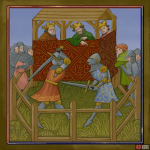Text
In the High Middle Ages, new elements of combat techniques and weapons and armour emerged. Curved sabres became popular, and chainmail was replaced by plate armour. Knights preferred heavier swords, crossbows, and impact weapons such as maces and flails.
Only wealthy nobles could afford full armour. Usually, only partial metal armour was worn, and more than for protection, the focus was on combat technique.
For this reason, swordfighting developed in two ways:
a) knightly swordsmanship – fighting with a spear, sword, and shield in full heavy armour
b) common swordsmanship – for lightly armoured fighters who fought with swords and common weapons such as falchions, flails, scythes, staffs, etc.
In battles between lightly armoured and heavily armoured fighters, speed, agility, and cleverness often won. Therefore, swordplay also interested the poorer parts of society. They gradually started to be educated in swordfighting schools. The training was not very professional, being based more on dexterity, readiness, and the use of various available means besides weapons.
Precise contemporary descriptions of duels are lacking, so historians rely on mentions in literature or preserved visual material.


No Comments